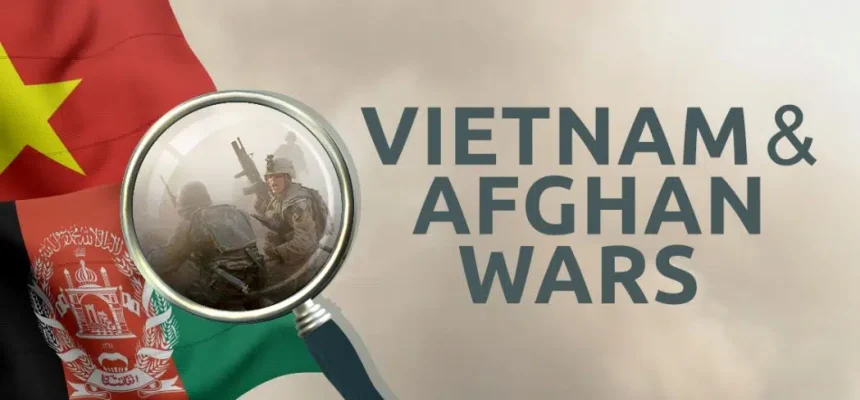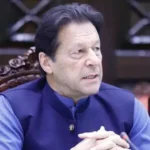The Vietnam and Afghanistan conflicts have been compared, but rarely from the perspective of the victims. How can they evaluate their pain among the haughty, never-ending demands of outsiders whose broken lives have been hidden beneath a thick layer of media blackout and for whom there is no prospect of advancement but only dismay of digression?
When comparing Afghanistan with Vietnam, it’s important to consider how little was achieved despite the enormous human cost and suffering incurred in each conflict, not only how much the US has lost in both. Or there might be no profits at all!
Ten years after the World War II bombs of Hiroshima and Nagasaki and five years after the Korean War, the US entered Vietnam. The US dropped 32,557 tonnes of napalm together with an average of 800 tonnes per day in Korea. On orders from Washington, General Emmett O’Donnell ordered the burning down of five North Korean cities, and the conflict cost 2.5 million lives on both sides. The United States only got involved in Vietnam because this blood was on their conscience.The statistics from Vietnam are heartbreaking. With over 500,000 US forces present, US planes launched eight million tonnes of bombs over South Vietnam – three times as much as were deployed throughout the entirety of World War II. The whole terrain of South Vietnam was utterly ruined by the use of napalm and Agent Orange. Three million Vietnamese were killed in this most expensive war, which cost over $140 billion at the time and was ultimately lost. It’s like mankind is killing itself with its own money!
First off, it was believed that the Vietnam War was being fought to defeat “communism,” which, by President Eisenhower’s “Domino Theory,” would take over all of Southeast Asia if Vietnam were to fall. However, the real objective was to retake control of Indochina, a former French colony that was eroding after World War II, much like all other colonies. Following the pattern, the US characterised the Taliban as a “totalitarian Shariah dictatorship” that was particularly harsh toward women, as well as the vice of “Islamist terrorism,” which sought to destroy the Western “way of life.” The US vowed to provide democracy to these governments’ whole populations during both conflicts.
Read More: The US Still Trying to Choke Afghanistan
However, the US’s initial action in both states was to establish a lasting division that would lead to a protracted war. A puppet government of the anti-Communists, led by Catholic Ngo Dinh Diem, who was brought in from the US two weeks before becoming prime minister, was installed in the South when Vietnam was split into the North and South. Again, this is comparable to the appointment of Hamid Karzai, who was appointed head of the Afghan interim government in the Bonn Agreement in Germany in December 2001 before taking office in Afghanistan. As the Taliban and the Northern Alliance were, at the moment, opposing foreign influence, Karzai was to support the Northern Alliance. The division was sparked by the majority’s perception of this inserted, unfamiliar rule as alien.
Both battles took a similar route, with the Vietcong employing guerrilla tactics including ambushes, booby traps, and the quick-disappearing strategy among dense jungles, tunnels, and local populations. These methods prevented the US soldiers from coming into contact with the enemy, pushing them to revert to mass murder. In a series of “Search and Destroy” operations, American forces tracked down, bombed, and destroyed the Vietcong’s supply routes, driving them into direct battle while US Generals started gauging their success by the number of casualties.
The Taliban in Afghanistan hide out in the dry and steep terrain, which is crisscrossed with natural caves and trails that are only known to the local tribesmen. The US would have assured a swift withdrawal from Afghanistan if it had learned from the past that “the guerrilla wins if he does not lose and the regular army loses if it does not win.” However, after 17 years and more than a trillion dollars having been spent, the war has become an illogical “mission creep” for the US, while the Taliban have had time to adjust to their adversary’s more sophisticated capabilities. The Taliban troops, according to a 2013 study, were engaged in “complicated ambushes that displayed fire control, fire discipline, interlocking fields of fire, combined weapons, fire and manoeuvring, anti-armour tactics, cover and concealment, and defence in depth.” Additionally, it is said that the Taliban Red Units have taken over the area of the night that was once supposed to belong to the US Special Forces.
Read More: Afghanistan: The Economic Game Changer
Sweep and Clear missions in Afghanistan have appropriately replaced Vietnam’s “Search and Destroy” missions. These are very helpful in reinvigorating revanchism and fortifying the will to fight back. It turns out that the Taliban are the sons and brothers of the people, and their death is lamented. The adversary that the US had imagined was something like a detached, despised other that could be marked out from the local people.
The US’s belief that it could establish local armies—the Army of the Republic of Vietnam (ARVN) in Vietnam and the Afghan National Army (ANA) in Afghanistan—to fight the freedom fighters on its behalf was another miscalculation in both conflicts. But neither of these armies—nor the installed administrations that were ostensibly aiding in advancing “democracy-building”—ever attained the fortitude necessary to battle one’s people for the success of a foreign oppressor.
In actuality, the Vietcong guerrillas were viewed as fighting an existential war, a battle of national reunification, and a freedom fight against occupiers, and this is precisely how the majority of Afghans view the Taliban. The Taliban commander, Mullah Mohammad Omar’s 67-article code of conduct for his militants, which instructed them to protect civilians, reflects the Taliban’s shift away from their prior harsh image. The Taliban have also ceased attacking health centres and immunisation initiatives, as well as destroying schools.
In other words, if the US had learned from the Vietnam War, a few insurgents would not have kept the nation at a standstill for 17 years. To accomplish any sort of peace now, the US must contact the Taliban. However, this approach is rarely sincere since the US has been attempting to foment division among Taliban factions, which has proved more detrimental. The US needs to realise that even though it has the best military in the world, it is occupying someone else’s home and will eventually need to offer more and accept less to depart amicably.
Now you can follow SRI on Twitter, LinkedIn, Instagram, and Facebook for insights on News, infographics, Live Updates, Article, and Web infographics within the country or across the world.






